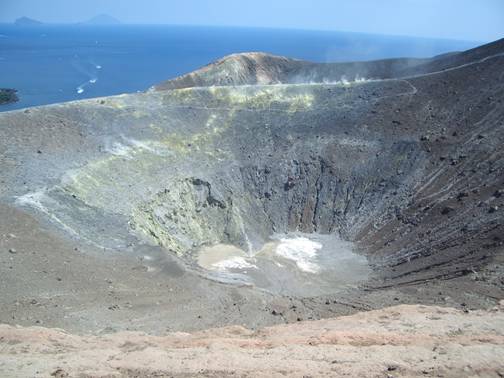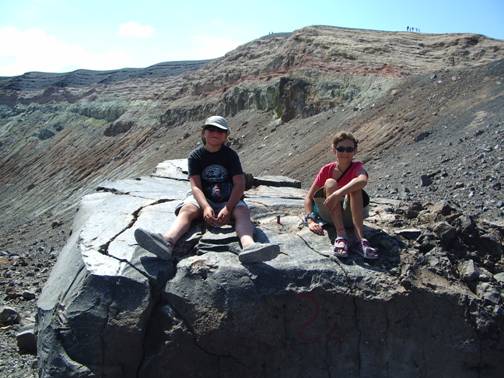From Palermo we motor sailed along the north coast of Sicily. The coast road
was visible most of the way as it burrowed through the parched mountain terrain
via tunnels and passed high over the valleys via long road bridges. We can only
imagine that the programme of road works in Sicily must be horrendous to maintain the
chain of tunnels and bridges.

The rocky coast and misty mountains making up the north
coast of Sicily.

The coast road burrowed through the mountains and soared
over the valleys.
We anchored overnight at Porticello and Cefalù, both
times in clear water over sand, and saw lots of little flat fish hovering the
sand disturbed by our anchor chain. I dug out Anne Hammick and found a good
place to hang her in the cockpit.

Anne Hammick and me, relaxing in the
cockpit.
The Aeolian
Islands
Eventually we turned left and headed for the Aeolian Islands. The Aeolian Islands are the peaks of
seven volcanoes, and two are still active – Stromboli and Vulcano. The islands are named after Aeolus,
god of the winds. In Homer’s Odyssey,
it was Aeolus who gave Odysseus all four winds tied up in a bag to help him to
get home to Ithaca in Greece after the
Trojan War. Unfortunately, as they were nearing Ithaca, his crew opened the bag
thinking that it contained treasure – this let all the winds loose and blew
Odysseus’ ship off course and further delayed his return.

Our first glimpse of the Aeolian
Islands, Filicudi and Alicudi.
Vulcano
We headed for Vulcano on a volcano-climbing mission. The
island emerged from the sea in 183 BC and last erupted in 1890. It is a
strangely shaped island consisting of extinct and almost extinct craters, with
black sand beaches, bubbling mud and hot mineral springs (and a pervasive eggy
smell). As the recommended anchorage on the west side of Vulcano (Porto di
Ponente) was full when we arrived, we anchored overnight in 12 metres of deep
blue water in Spiaggia di Vinci on the Island of Lipari opposite.

Sunset over Spiaggia di
Vinci.

The
next morning, we woke to the view of the main crater of Vulcano smoking
gently.
When Porto di Ponente emptied a little we found a space
to park and spent a day swimming and snorkelling – and contemplating the path up
the volcano.

The path to the crater can be seen along the tree line
and up through the ash.
When the wind blew up from the north west, we upped
anchor and went to the anchorage on the eastern side of the island (Porto di
Levante) – along with everyone else. The water was quite deep for anchoring and
the holding was mixed – lots of boats dragged anchor in the blustery rainy
weather we had the next day (the first rain that we have seen since April…).
Luckily, we managed to get our anchor to hold AND picked up a sturdy mooring
line lurking just below the surface. Small lumps of pumice floated past us in
the water, washed off the beach by the rain.
Connecting across the
anchorage
An Italian boat came in to anchor
alongside CAPE, with three children on board.
Nintendo DSs were spotted on both boats, and all five kids were connected across
the anchorage before the anchor was even in! The Nintendo DS session was
followed by noisy swimming games, and an invitation to Beth and Bryn to join
Susanna, Flavio and Simone
(and Andrea and Marella) for a trip ashore to the mud
baths and pizza. The fact that children aren’t allowed in the mud baths didn’t
stop the fun, as there was a black volcanic beach to explore and hot,
sulphur-smelly water with bubbles to swim in (fart jokes are big on our boat at
the moment). The next evening we all got together on CAPE for a drink, local cakes, and a DVD for the kids –
all squished around the chart table.

Bethany,
Bryn, Susanna, Flavio and Simone engrossed in Blue Planet.
Climbing the
volcano
The next morning we got up early-ish – to
climb the volcano before it got too hot.

Welcome to the volcano!
The one-and-a-half-hour walk up to the crater was
punishing – the path was coarse black sand to start with, like walking across a
beach of soft sand, but uphill. The sand gave way to hard-packed pink ash,
uneven and crossed with gullies where the recent rain had scoured the surface.
Once we reached the rim of the crater, the surface was a lunar landscape of ash,
pumice, and rocks, but at least there was a strong, cool
breeze.

Trekking across a lunar landscape on the rim of the
volcano.

Looking down from the rim of the crater into the mud in
the crater itself, and across to the sulphurous fumaroles on the far
side.

Beth and Bryn sitting on a lump of rock blown out of the
crater during an earlier eruption. The groups of people walking the rim of the
crater give some idea of the scale of the volcano.

Bryn on top of the world (395 metres).

The view from the top was reminiscent of the view from Shirley’s Heights in Antigua.
The view from the top of the volcano was stunning. The
two anchorages (and CAPE if you know where to look) can be clearly seen, as well
as the Island of
Lipari opposite. We stopped
for a rest, a drink and to eat some oranges that we’d brought with us in true Famous Five style. A small lizard
approached us – he could obviously smell the water and fruit – and stayed close
to eat some orange that we threw to him.
A lizard on the scrounge.
We thought going up was tough, but going back down was
hard on the knees and seemed to get even harder as we descended into the
heat.
Stromboli
After having climbed Vulcano, we were keen to see
Stromboli, which is a real, lava-spewing, volcano-shaped volcano rising to 925
metres, that (very conveniently for the parents of by now avid young
volcanologists) is in a state of almost continuous activity. While the
pyrotechnics weren’t quite as spectacular as we hoped, we definitely saw lava
vomited into the night sky every 20 minutes or so, accompanied by an impressive
rumble from deep inside the mountain.
On-board volcano
We topped our volcano-fest by building the volcano that
Bryn had for one of his birthdays – a plaster of Paris affair involving poster
paint, vinegar, baking soda and food colouring. It was fun to build and
decorate, but wasn’t a patch on the real thing. We’re going to see if we can use
the mould to make a chilled chocolate cake volcano…

Volcano under construction.

Volcano in action.
Straits of Messina
Having rounded Stromboli (the ‘lighthouse of the
Mediterranean’), we turned south towards the Straits of Messina – the narrow
stretch of water between the toe of Italy and Sicily. The twin perils of Scilla and
Charybdis can be found in the Straits of Messina, and were dangers that were
tackled by Odysseus on his journey home. Scilla was supposed to be a monster who
(like all mythical monsters worth their salt) lived in a cave on top of a sheer
cliff, and who had 12 feet and 6 long necks with horrible heads that plucked
swordfish, dolphins and unlucky sailors from ships as they passed. Opposite was
Charybdis – a giant whirlpool – that sucked down whole ships. Apparently
Odysseus chose to pass closer to Scilla than Charybdis and lost a few crew to
the monster. An earthquake in 1783 is reported to have altered the topography of
the sea floor and tamed the twin perils. It is, however, still important to pass
through the Straits at a specific point in the tide to avoid the pull of
Charybdis and other whirlpools in this stretch of water.
Rocella Ionica
Having escaped the clutches of Scilla and Charybdis
unscathed, we motored along the sole of Italy’s boot and anchored overnight off the beach
at Galati. The
next day we headed for the marina at Rocella Ionica – our jumping off point for
Greece. Previously a free marina, it
started charging a couple of weeks before we got there (typical!).
We were disappointed to find that we’d used most of the
fuel that we’d taken on at Palermo – or at least we thought we had. This
meant that our fuel consumption had not improved since getting the injectors
serviced and so on. (Alarm bells should have started ringing faintly at this
point.) However, fuel was available by tanker, so we arranged to have some
delivered. The alarm bells should have got louder when a) I couldn’t see the
fuel level in the port-side fuel tank and the conclusions that I came to were
that it was totally full or totally empty (we should have checked but didn’t),
and (alarm bells deafening by now) b) the tanker arrived with a large-bore,
high-pressure hose. When Mr Fuel Tanker started pumping there was a loud bang as
the full-to-the-brim port-side fuel tank split, dumping 200 litres of hot diesel
into the engine room and over David. We got Mr Fuel Tanker to stop pumping and
quickly starting pumping by hand the remaining fuel from the split tank, plus as
much as we could of the spilt fuel in the engine room into jerry cans and then
into the empty starboard tank. Luckily we have two fuel tanks and could isolate
the split one. The engineer who worked on the fuel filter in Palermo must have shut the
port tank off at some point – and we had never thought to check it because we
never shut it off. Looking on the bright side (there is always one if you look
hard enough), we hadn’t used all our fuel and our fuel consumption has improved!
We cleaned up the diesel from the engine room, the decks (where the tank
overflows had sprayed it) and us, and scurried off in the general direction of
Greece…


















